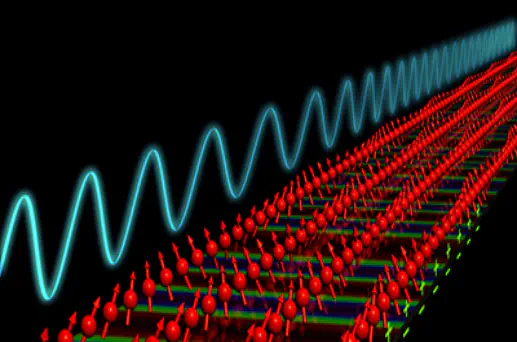 Image taken from: https://physics.aps.org/articles/v7/s84
Image taken from: https://physics.aps.org/articles/v7/s84Overview:
High-Harmonic Generation (HHG) is a non-linear optical process wherein higher multiples of the fundamental frequency of an input light are generated1. While extensively studied in electronic systems, HHG in quantum spin systems remains less explored, offering novel insights into material properties and magnetic dynamics23. This research aims to investigate HHG within one-dimensional spin chains featuring both the XXZ interaction and the Dzyaloshinskii-Moriya Interaction (DMI), a key mechanism in systems with broken inversion symmetry45. Spin systems exhibiting DMI have recently attracted considerable attention in various fields, including the study of magnetised thin films 678, graphene 9, spin-1/2 ladders 10, multiferroic phases 11, anisotropic Heisenberg antiferromagnets 12 and XY spin chains 13, highlighting the broad relevance and interdisciplinary nature of research in this field.
Background
In quantum spin systems, magnetic fields can induce dynamics leading to HHG through time-dependent magnetization changes. The inclusion of DMI adds a critical layer of complexity. DMI leads to spin canting and is crucial for understanding phenomena such as magnetic skyrmions and certain magnetoelectric effects, which are vital for spintronic applications.
Objectives:
The primary objective of this research is to theoretically explore the effects of DMI on the HHG spectrum in one-dimensional ferromagnetic spin chains, analyzing how broken inversion symmetry influences the generation of harmonics. Specifically, the project will:
- Develop a theoretical model incorporating both XXZ and DMI interactions.
- Use numerical simulation tools to predict the HHG spectrum.
- Analyze the role of magnon excitations and their coupling due to DMI in the generation of high harmonics.
Methodology:
The research will employ numerical simulations, particularly using exact diagonalization or time dependent Matrix product techniques 14, to study the spin dynamics under periodic magnetic driving. Initial conditions will mimic real-world materials where DMI plays a significant role. The study will utilize Python and potentially Julia for performance-critical simulations, alongside libraries such as QuTiP15/iTensors16 for quantum dynamics.
Expected Outcomes:
- How DMI influences the cutoff energies in the HHG spectrum.
- The potential for phase transitions induced by high magnetic fields and their effects on the HHG.
- Insights into the spin excitation characteristics modified by DMI, enhancing the understanding of spin-based devices.
Significance:
This research is positioned at the cutting edge of quantum materials and photonics, promising to deepen the theoretical understanding of spin dynamics in non-centrosymmetric systems and contribute to the development of next-generation magnetic materials with tailored optical properties.
Contact persons
Prof. Martin Gärttner and Javad Vahedi
IFTO, Friedrich-Schiller-University Jena.
References:
High-harmonic generation in quantum spin systems, Phys. Rev. B 99, 184303 (2019). ↩︎
Photo-induced nonequilibrium states in Mott insulators, arXiv:2310.05201 ↩︎
High-harmonic generation in spin-orbit coupled systems, Phys. Rev. B 102, 081121(R) (2020). ↩︎
Anisotropic Superexchange Interaction and Weak Ferromagnetism, Phys. Rev. 120, 91 (1960). ↩︎
A thermodynamic theory of “weak” ferromagnetism of antiferromagnetics, Journal of Physics and Chemistry of Solids 4, 241-255, (1958). ↩︎
Measuring and tailoring the Dzyaloshinskii-Moriya interaction in perpendicularly magnetized thin films, Phys. Rev. B 90, 020402(R) (2014). ↩︎
Dzyaloshinskii-Moriya interaction accounting for the orientation of magnetic domains in ultrathin films: Fe/W(110), Phys. Rev. B 78, 140403(R) (2008). ↩︎
Skyrmion confinement in ultrathin film nanostructures in the presence of Dzyaloshinskii-Moriya interaction, Phys. Rev. B 88, 184422 (2013). ↩︎
Unraveling Dzyaloshinskii–Moriya Interaction and Chiral Nature of Graphene/Cobalt Interface, Nano Lett. 18, 5364 (2018). ↩︎
Emergent spin-1 Haldane gap and ferroelectricity in a frustrated spin-1/2 ladder., Phys. Rev. B 101, 140408 (2020). ↩︎
Role of the Dzyaloshinskii-Moriya interaction in multiferroic perovskites, Phys. Rev. B 73, 094434 (2006) ↩︎
Spin-1/2 anisotropic Heisenberg antiferromagnet model with Dzyaloshinskii-Moriya interaction via mean-field approximation, J. Magn. Magn. Mater. 462, 8 (2018). ↩︎
Topological phase transition of the anisotropic XY model with Dzyaloshinskii-Moriya interaction, Phys. Rev. B 98, 085136 (2018). ↩︎
Time-evolution methods for matrix-product states, Annals of Physics 411, 167998 (2019). ↩︎